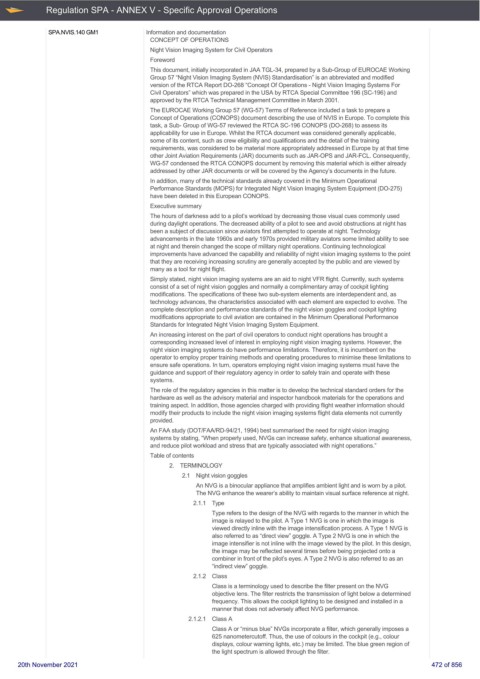Page 472 - UK Air Operations Regulations 201121
P. 472
~
~ Regulation SPA - ANNEX V - Specific Approval Operations Centrik
SPA.NVIS.140 GM1 Information and documentation
CONCEPT OF OPERATIONS
Night Vision Imaging System for Civil Operators
Foreword
This document, initially incorporated in JAA TGL-34, prepared by a Sub-Group of EUROCAE Working
Group 57 “Night Vision Imaging System (NVIS) Standardisation” is an abbreviated and modified
version of the RTCA Report DO-268 “Concept Of Operations - Night Vision Imaging Systems For
Civil Operators” which was prepared in the USA by RTCA Special Committee 196 (SC-196) and
approved by the RTCA Technical Management Committee in March 2001.
The EUROCAE Working Group 57 (WG-57) Terms of Reference included a task to prepare a
Concept of Operations (CONOPS) document describing the use of NVIS in Europe. To complete this
task, a Sub- Group of WG-57 reviewed the RTCA SC-196 CONOPS (DO-268) to assess its
applicability for use in Europe. Whilst the RTCA document was considered generally applicable,
some of its content, such as crew eligibility and qualifications and the detail of the training
requirements, was considered to be material more appropriately addressed in Europe by at that time
other Joint Aviation Requirements (JAR) documents such as JAR-OPS and JAR-FCL. Consequently,
WG-57 condensed the RTCA CONOPS document by removing this material which is either already
addressed by other JAR documents or will be covered by the Agency’s documents in the future.
In addition, many of the technical standards already covered in the Minimum Operational
Performance Standards (MOPS) for Integrated Night Vision Imaging System Equipment (DO-275)
have been deleted in this European CONOPS.
Executive summary
The hours of darkness add to a pilot’s workload by decreasing those visual cues commonly used
during daylight operations. The decreased ability of a pilot to see and avoid obstructions at night has
been a subject of discussion since aviators first attempted to operate at night. Technology
advancements in the late 1960s and early 1970s provided military aviators some limited ability to see
at night and therein changed the scope of military night operations. Continuing technological
improvements have advanced the capability and reliability of night vision imaging systems to the point
that they are receiving increasing scrutiny are generally accepted by the public and are viewed by
many as a tool for night flight.
Simply stated, night vision imaging systems are an aid to night VFR flight. Currently, such systems
consist of a set of night vision goggles and normally a complimentary array of cockpit lighting
modifications. The specifications of these two sub-system elements are interdependent and, as
technology advances, the characteristics associated with each element are expected to evolve. The
complete description and performance standards of the night vision goggles and cockpit lighting
modifications appropriate to civil aviation are contained in the Minimum Operational Performance
Standards for Integrated Night Vision Imaging System Equipment.
An increasing interest on the part of civil operators to conduct night operations has brought a
corresponding increased level of interest in employing night vision imaging systems. However, the
night vision imaging systems do have performance limitations. Therefore, it is incumbent on the
operator to employ proper training methods and operating procedures to minimise these limitations to
ensure safe operations. In turn, operators employing night vision imaging systems must have the
guidance and support of their regulatory agency in order to safely train and operate with these
systems.
The role of the regulatory agencies in this matter is to develop the technical standard orders for the
hardware as well as the advisory material and inspector handbook materials for the operations and
training aspect. In addition, those agencies charged with providing flight weather information should
modify their products to include the night vision imaging systems flight data elements not currently
provided.
An FAA study (DOT/FAA/RD-94/21, 1994) best summarised the need for night vision imaging
systems by stating, “When properly used, NVGs can increase safety, enhance situational awareness,
and reduce pilot workload and stress that are typically associated with night operations.”
Table of contents
2. TERMINOLOGY
2.1 Night vision goggles
An NVG is a binocular appliance that amplifies ambient light and is worn by a pilot.
The NVG enhance the wearer’s ability to maintain visual surface reference at night.
2.1.1 Type
Type refers to the design of the NVG with regards to the manner in which the
image is relayed to the pilot. A Type 1 NVG is one in which the image is
viewed directly inline with the image intensification process. A Type 1 NVG is
also referred to as “direct view” goggle. A Type 2 NVG is one in which the
image intensifier is not inline with the image viewed by the pilot. In this design,
the image may be reflected several times before being projected onto a
combiner in front of the pilot’s eyes. A Type 2 NVG is also referred to as an
“indirect view” goggle.
2.1.2 Class
Class is a terminology used to describe the filter present on the NVG
objective lens. The filter restricts the transmission of light below a determined
frequency. This allows the cockpit lighting to be designed and installed in a
manner that does not adversely affect NVG performance.
2.1.2.1 Class A
Class A or “minus blue” NVGs incorporate a filter, which generally imposes a
625 nanometercutoff. Thus, the use of colours in the cockpit (e.g., colour
displays, colour warning lights, etc.) may be limited. The blue green region of
the light spectrum is allowed through the filter.
20th November 2021 472 of 856

